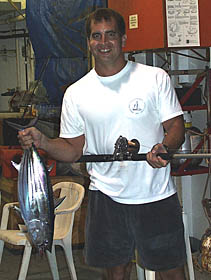|
|
  TODAY'S WEATHER Blue skies with haze 73.4°F (23°C) Latitude: 0 deg 31’S Longitude: 91 deg 31’W Wind Direction: Variable Wind Speed: 8-10 Knots Sea State: 1 Swell(s) Height: 3-6 Foot Sea Temperature: 77°F (25°C) Barometric Pressure: 1010 MB Visibility: 5-10 Nautical Miles  Breakfast Creamed chipped beef over toast points Glazed doughnuts Walnut Waffles Hash browns and hot cereal Bacon and sausage Eggs to order Pineapple and melon Dry cereal Lunch Turkey, bacon and Swiss sandwich Grilled Ahi Split pea and ham soup French fries Salad bar Dinner T-bone steaks Fried shrimp Baked potato Green bean casserole Fresh baked dinner rolls Salad bar Easter Cake a la mode 
Mapping submarine volcanic rift zones on Fernandina Island If you have looked at the Plate Tectonics module in the Deeper Discovery section of the web site, you know that many volcanoes occur at the edges of plates that move either towards each other or away from each other. However, there are other groups or “chains” of volcanoes that develop in the middle of tectonic plates. They often form lines of volcanoes that are created as the tectonic plates move over “hotspots” -- plumes of hot material that rise through the mantle. Linear chains of islands and seamounts (volcanoes whose tops do not reach sea level), such as the Hawaiian Islands and Emperor Seamount Chain, and groups of islands, like the Galapagos Islands, are example of hotspot volcanic chains. Each island may be made of one or more individual volcanoes. Fernandina Island, the westernmost island in the Galapagos archipelago, is an island formed by a single volcano named “La Cumbre”. La Cumbre volcano is the most active volcano in the Galapagos Archipelago. It rises 4600 feet above sea level and has young lava flows over all its slopes. It last erupted in 1995 on its southwestern flank. Fernandina is in one of the most remote areas in the Galapagos Islands, and there are no permanent human inhabitants. For this reason, there are not very good records of many of the eruptions. One of the best described eruptions occurred in 1968, when a huge ash cloud was seen for many miles. When a team of volcanologists reached the summit after the eruption, they saw that the caldera floor had dropped by almost 1000 feet! This was caused by the rocks on the caldera floor collapsing into the hole left behind by the erupting magma. The caldera is now 5 miles across and 3300 feet deep. Although geologists have collected samples from the parts of the volcano that are exposed, there has been very little work on the submarine part of Fernandina. That is surprising when most of the volume of the volcano is underwater (see the slideshow for a 3-D image of the western submarine flank of Fernandina we made using the multibeam data we collected). The most recent eruption in the Galapagos Islands occurred in 1998 at Cerro Azul, which is the southernmost volcano on Isabela Island -- the biggest island in the archipelago. Isabela has five active volcanoes: Cerro Azul, Sierra Negra, Alcedo, Darwin, and Wolf (from south to north). Although there have been other eruptions in the Galapagos, the two western islands of Isabela and Fernandina are where the action is for volcanologists! Fernandina and Isabela Islands have also been visited by other explorers. In 1835 during a five-week visit to the islands, Charles Darwin visited Tagus Cove, which lies on the western shore of Isabela Island. The cove is in the middle of a small volcanic ash cone -- one of several that formed during an eruption of Darwin Volcano. When the hot, flowing lavas from Darwin Volcano ran into the cold ocean water, explosions created volcanic ash that was then deposited in a circle around the place where the lava entered the sea. This afternoon, RV Melville sailed down the Bolivar Canal (the narrow channel between Isabela and Fernandina Islands), and entered Tagus Cove. We got a great look at this historical site! Tagus Cove was named after the British naval ship, Tagus, which landed there in 1814 in search of tortoises. The cove was also used as a refuge for pirate and whaling ships in the 1700-1800s. Sailors carved their ships’ names into the soft volcanic ash rock that forms the cliffs of the cove. Although we could not see them from the ship, we are told that if you look closely, you can see the names of vessels going back to the 1700’s. Today, it is illegal to mark the walls of Tagus Cove, but the historical graffiti serves as a vivid reminder of the many people who have visited the Galapagos Islands through the centuries. Over the past three days, we have been multibeam mapping and sampling lava west of Fernandina Island. This evening, we headed back to Academy Bay on Santa Cruz Island to drop off Mark Kurz and Josh Curtis (both from Woods Hole Oceanographic Institution), and the three official Ecuadorian observers who were out with us for the past 3 days. Tomorrow, RV Melville will steam at full speed to the northwest, to the mid-ocean ridge crest along the Galapagos Rift at 97.5°W. At that location, we will be looking for a submarine volcanic eruption that took place about 18 months ago based on the T-phase seismicity recorded by the Autonomous Hydrophone Array. Join us as we explore for and study what may be the youngest mid-ocean ridge volcanic eruption so far on this expedition!
|
|||||||||||||||||||||||||||||||||||||||||||||||||||||||||||||||||||||||||||||||||||||||||||||||||||||||||||||||||||||||||||||||||||||||||||||||||||||||||||||||||||
© 2010 Dive and Discover™. Dive and Discover™ is a registered trademark of
Woods
Hole Oceanographic Institution
